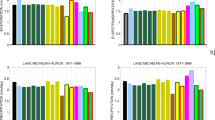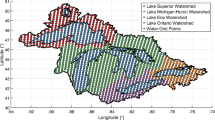Abstract
Hydrological models of the Great Lakes basin were used to study the sensitivity of Great Lakes water supplies to climate warming by driving them with meteorological data from four U.S. climate zones that were transposed to the basin. Widely different existing climates were selected for transposition in order to identify thresholds of change where major impacts on water supplies begin to occur and whether there are non-linear responses in the system. The climate zones each consist of 43 years of daily temperature and precipitation data for 1,000 or more stations and daily evaporation-related variables (temperature, wind speed, humidity, cloud cover) for approximately 20–35 stations. A key characteristic of these selected climates was much larger variability in inter-annual precipitation than currently experienced over the Great Lakes. Climate data were adjusted to simulate lake effects; however, a comparison of hydrologic results with and without lake effects showed that there was only minor effects on water supplies.
Similar content being viewed by others
References
Bates, G. T., Hostetler, S.W., and Giorgi, F.: 1995, ‘Two-Year Simulation of the Great Lakes Region with a Coupled Modeling System’, Mon. Wea. Rev. 123, 1505-1522.
Blust, F. and DeCooke, B. G.: 1960, ‘Comparison of Precipitation on Islands of Lake Michigan with Precipitation on the Perimeter of the Lake’, J. Geophys. Res. 65, 1565-1572.
Braham, R. R. and Dungey, M. J.: 1995, ‘Lake Effect Snowfall over Lake Michigan’, J. Appl. Meteor. 34, 1009-1019.
Changnon, S. A.: 1968, Precipitation Climatology of Lake Michigan Basin, Bulletin 52, Illinois State Water Survey, Urbana, IL, p. 46.
Changnon, S. A.: 1991, ‘Development and Use of Climate Analogues’, in Proceedings, Symposium on Climate Scenarios, University of Waterloo, Waterloo, Ontario, pp. 49-58.
Coordinating Committee on Great Lakes Basin Hydraulic and Hydrologic Data: 1977, Coordinated Great Lakes Physical Data, U.S. Army District Engineer, Detroit, p. 33.
Croley, T. E., II: 1990, ‘Laurentian Great Lakes Double-CO2 Climate Change Hydrological Impacts’, Clim. Change 17, 27-47.
Croley, T. E., II: 1994, ‘Hydrological Impacts of Climate Change on the Laurentian Great Lakes’, in Trends in Hydrology 1, Council of Scientific Research Integration, Research Trends, Kaithamukku, Trivandrum, India, pp. 1-25.
Croley, T. E., II: 1995, ‘Laurentian Great Lakes Dynamics, Climate, and Response to Change’, in Oliver, H. R. and Oliver, S. A. (eds.), The Role of Water and Hydrological Cycle in Global Change 31, Proceedings of the NATO Advanced Study Institute, NATO ASI Series 1: Global Environmental Change, SpringerVerlag, Berlin, pp. 251-296.
Croley, T. E., II and Hartmann, H. C.: 1985, ‘Resolving Thiessen Polygons’, J. Hydrol. 76, 363-379.
Croley, T. E., II and Hartmann, H. C.: 1987, ‘Near Real Time Forecasting of Large Lake Supplies’, J. Water Resour. Plann. Manage. Div. 113, 810-823.
Croley, T. E., II and Hartmann, H. C.: 1989, ‘Effects of Climate Changes on the Laurentian Great Lakes Levels’, in Smith, J. B. and Tirpak, D. A. (eds.), The Potential Effects of Global Climate Change on the United States: Appendix A - Water Resources, U.S. Environmental Protection Agency, Washington, D.C., pp. 41-434.
Croley, T. E., II and Hartmann, H. C.: 1990, ‘GLERL’s Near Real Time Hydrological Outlook Package’, in Hartmann, H. C. and Donahue, M. J. (eds.), Proceedings, Great Lakes Water Level Forecasting and Statistics Symposium, Great Lakes Commission, Ann Arbor, Michigan, pp. 63-72.
Croley, T. E., II, Quinn, F. H., Kunkel, K. E., and Changnon, S. A.: 1996, Climate Transposition Effects on the Great Lakes Hydrological Cycle, NOAA Technical Memorandum ERL GLERL-89, Great Lakes Environmental Research Laboratory, p. 100.
Croley, T. E., II, Quinn, F. H., Kunkel, K. E., and Changnon, S. A.: 1998, ‘Great Lakes Hydrology under Transposed Climates’, Clim. Change 38, 405-433.
Day, P. C.: 1926, ‘Precipitation in the Drainage Area of the Great Lakes, 1875-1924’, Mon. Wea. Rev. 54, 85-106.
Farnsworth, R. K., Peck, E. L., and Thompson, E. S.: 1982, Evaporation Atlas for the Contiguous 48 States, NOAA Technical Report NWS 33, U.S. Dept. of Commerce, Washington, D.C., p. 26, 4 maps.
Freeman, N. G. and Haras, W. S.: 1978, What You Always Wanted to Know About Great Lakes Levels and Didn’t Know Whom to Ask, Environment Canada, Ottawa.
Gatz, D. F. and Changnon, S. A., Jr.: 1976, Atmospheric Environment of Lake Michigan, Environmental Status of the Lake Michigan Region, 8. Rep. ANL/ES40, Argonne National Laboratory, p. 164.
Hartmann, H. C.: 1990, ‘Climate Change Impacts on Laurentian Great Lake Levels’, Clim. Change 17, 49-67.
Horton, R. E. and Grunsky, G. E.: 1927, Hydrology of the Great Lakes, Chicago Sanitary District Report.
International Joint Commission: 1993, Climate, Climate Change, Water Level Forecasting and Frequency Analysis, Levels Reference Study, Phase II, Final Report of Task Group 2, Working Committee 3, Lee, D. H. (ed.), p. 211.
Lyons, W. A.: 1966, ‘Some Effects of Lake Michigan Upon Squall Lines and Summertime Convection’, Great Lakes Res. J. 15, 259-272.
Mitchell, J. F. B., Manabe, S., Tokioka, T., and Meleshko, V.: 1990, ‘Equilibrium Climate Change’, in Houghton, J. T., Jenkins, G. J., and Ephraums, J. J. (eds.), Climate Change: The IPCC Scientific Assessment, Cambridge University Press, Cambridge, pp. 131-170.
Petterssen, S. and Calabrese, P. A.: 1959, ‘On Some Weather Influences Due to Warming of the Air by the Great Lakes in Winter’, J. Meteorol. 16, 646-652.
Scott, R. W. and Huff, F. A.: 1996, ‘Impacts of the Great Lakes on Regional Climate Conditions’, J. Great Lakes Res. 22, 845-863.
U.S. Army Crops of Engineers: 1985, Great Lakes Water Level Facts, U.S. Government Printing Office, Washington, D.C.
U.S. Environmental Protection Agency: 1989, The Potential Effects of Global Climate Change on the United States, Report to Congress, Smith, J. B. and Tirpak, D. A. (eds.), Report EPA2300589050, EPA Office of Policy, Planning, and Evaluation, Washington, D.C.
Author information
Authors and Affiliations
Rights and permissions
About this article
Cite this article
Kunkel, K.E., Changnon, S.A., Croley II, T.E. et al. Transposed Climates for Study of Water Supply Variability on the Laurentian Great Lakes. Climatic Change 38, 387–404 (1998). https://doi.org/10.1023/A:1005351026653
Issue Date:
DOI: https://doi.org/10.1023/A:1005351026653




